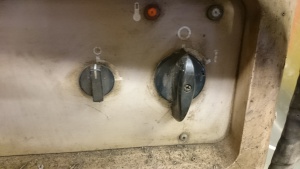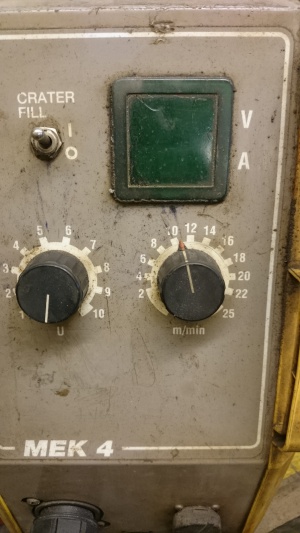Difference between revisions of "ESAB MIG Welder"
| Line 12: | Line 12: | ||
[[File:ESAB MIG Main Switches.JPG|frameless|left|Power and water pump switches]]<br> | [[File:ESAB MIG Main Switches.JPG|frameless|left|Power and water pump switches]]<br> | ||
This is the power switch (the larger one on the right) and the switch for the water cooling pump (the smaller one on the left).'''Running the water cooling pump without a torch attached will damage the pump.''' The pump needs to be able to circulate through something.<br><br><br><br><br> | This is the power switch (the larger one on the right) and the switch for the water cooling pump (the smaller one on the left).'''Running the water cooling pump without a torch attached will damage the pump.''' The pump needs to be able to circulate through something.<br><br><br><br><br> | ||
| + | |||
| + | [[File:ESAB MIG Wire Feeder Controls.JPG|frameless|left|Front panel of wire feeder unit]]<br> | ||
| + | This is the wire feed unit. At the back are connections for the welding current, water cooling, shielding gas and communications cable. On the front are connections for the mig torch (a euro style connector and two water cooling couplings) and for a remote control. There are two control knobs and a display. The left hand knob sets the welding voltage. The actual voltage used during the last weld will be displayed during the weld and after you finish. The right hand knob sets the wire feed speed. The switch is for 'crater fill' - this makes the machine taper off when you stop welding to try and avoid leaving a crater at the end of the weld. <br><br><br><br> | ||
==Manuals== | ==Manuals== | ||
Revision as of 12:50, 4 January 2017
MIG (Metal Inert Gas) welding (also known as GMAW - Gas Metal Arc Welding) uses wire fed through a welding 'gun' or 'torch'. The arc is struck between the wire and the workpiece, and shielded by an inert gas pumped through the torch. For more information or an introduction to MIG welding, see the references at the bottom of this page.
Our MIG welder is an ESAB LAW 500W witha separate wire feeder. The feeder is an ESAB MEK 4. The mig torch is a 400 amp water cooled Binzel model.
Current Status
It has been tested, and it welds very nicely. However, the earth lead needs work (underway at the moment), and the feed rollers and contact tip need replacing. The feed roller mechanism needs some tuning.
Power Supply
Currently shares a 32A 415V socket with the SMAW (stick) welder. A separate socket will be installed soon.
Controls
This is the power switch (the larger one on the right) and the switch for the water cooling pump (the smaller one on the left).Running the water cooling pump without a torch attached will damage the pump. The pump needs to be able to circulate through something.
This is the wire feed unit. At the back are connections for the welding current, water cooling, shielding gas and communications cable. On the front are connections for the mig torch (a euro style connector and two water cooling couplings) and for a remote control. There are two control knobs and a display. The left hand knob sets the welding voltage. The actual voltage used during the last weld will be displayed during the weld and after you finish. The right hand knob sets the wire feed speed. The switch is for 'crater fill' - this makes the machine taper off when you stop welding to try and avoid leaving a crater at the end of the weld.
Manuals
LAW 500 Power Source (esab.com)
Useful References
A brief introduction from Miller - Mig Handbook (millerwelds.com)
A more comprehensive guide from Lincoln Electric - GMAW Guide (licolnelectric.com)
Video introduction to MIG welding (weldingtipsandtricks) - Mig Welding Basics (youtube.com)
Guide to welding filler metals - Basic Welding Filler Metal Technology Correspondence Course (esab.com)

